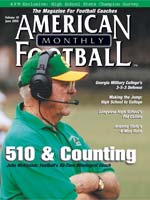Article CategoriesAFM Magazine
|
Under PressureGetting Home in the 4-man Rush© More from this issue Before I begin, I would like to thank the people at American Football
Monthly for giving me this opportunity. I also owe Coach Dirk Koetter
and Coach Brent Guy thanks for allowing me to represent our staff
in these pages. These are some concepts we believe in at Arizona
State. Hopefully, there are a few things you can use with your
players as well.
|
|
|||||||
| HOME |
MAGAZINE |
SUBSCRIBE | ONLINE COLUMNISTS | COACHING VIDEOS |
Copyright 2025, AmericanFootballMonthly.com
All Rights Reserved





